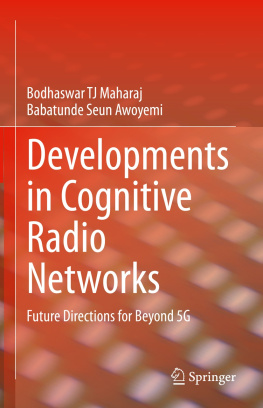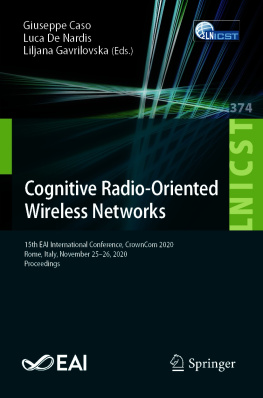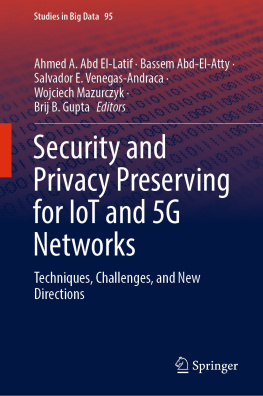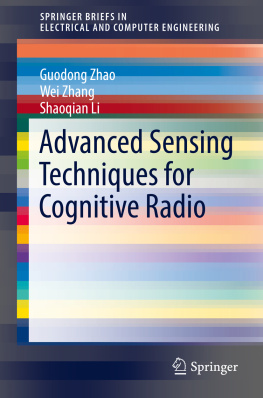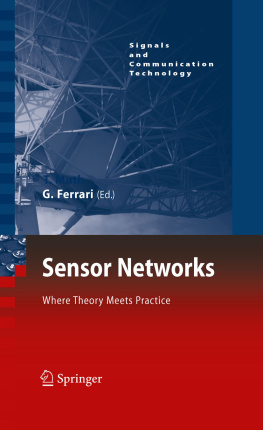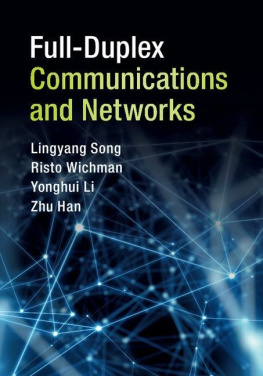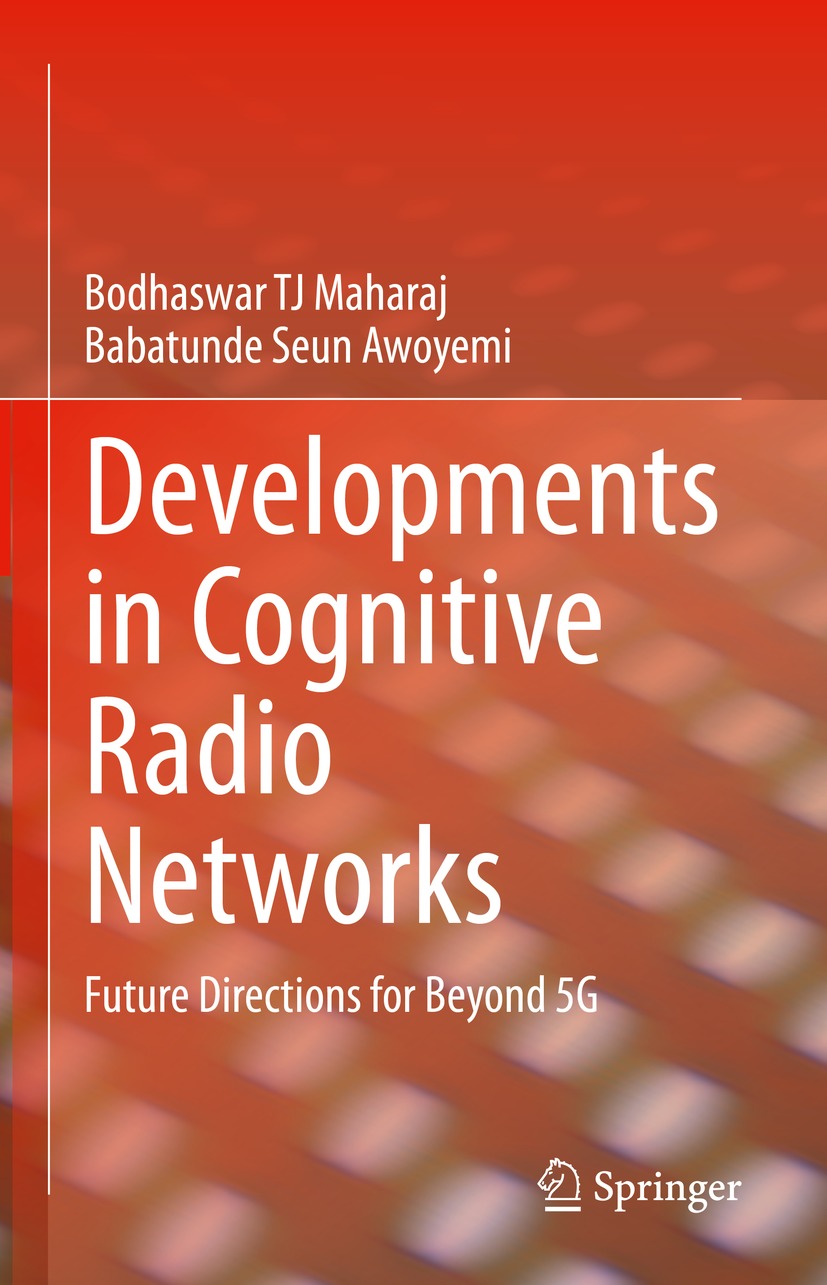Bodhaswar TJ Maharaj and Babatunde Seun Awoyemi
Developments in Cognitive Radio Networks
Future Directions for Beyond 5G
1st ed. 2022

Logo of the publisher
Bodhaswar TJ Maharaj
University of Pretoria, Pretoria, South Africa
Babatunde Seun Awoyemi
University of Pretoria, Pretoria, South Africa
ISBN 978-3-030-64652-3 e-ISBN 978-3-030-64653-0
https://doi.org/10.1007/978-3-030-64653-0
The Editor(s) (if applicable) and The Author(s), under exclusive license to Springer Nature Switzerland AG 2022
This work is subject to copyright. All rights are solely and exclusively licensed by the Publisher, whether the whole or part of the material is concerned, specifically the rights of translation, reprinting, reuse of illustrations, recitation, broadcasting, reproduction on microfilms or in any other physical way, and transmission or information storage and retrieval, electronic adaptation, computer software, or by similar or dissimilar methodology now known or hereafter developed.
The use of general descriptive names, registered names, trademarks, service marks, etc. in this publication does not imply, even in the absence of a specific statement, that such names are exempt from the relevant protective laws and regulations and therefore free for general use.
The publisher, the authors and the editors are safe to assume that the advice and information in this book are believed to be true and accurate at the date of publication. Neither the publisher nor the authors or the editors give a warranty, expressed or implied, with respect to the material contained herein or for any errors or omissions that may have been made. The publisher remains neutral with regard to jurisdictional claims in published maps and institutional affiliations.
This Springer imprint is published by the registered company Springer Nature Switzerland AG
The registered company address is: Gewerbestrasse 11, 6330 Cham, Switzerland
To family
Foreword
The field of cognitive radio networks is an important field in the development and realization of modern and future wireless communication networks. As the technology evolves, it is necessary to have not just an up-to-date account of its current state in the evolution process but also a detailed insight into its prospects and directions, especially in its drive towards being a key player in the nearest future of wireless communications. Thankfully, this book titled, Developments in Cognitive Radio Networks: Future Direction for Beyond 5G meets this need perfectly.
In the book, the authors provide a brief history on cognitive radio networks before delving into the important aspects of spectrum and resource realization and utilization for modern cognitive radio networks. The book exposes the most recent methods and models for resource optimization in cognitive radio networks and presents adequate analysis of these methods and models. It then examines the latest tools and techniques being employed to drive cognitive radio networks in the beyond 5G era, such as the concepts of queuing theory, cooperative diversity, stochastic geometry and deep learning. Ultimately, the book explores the promising prospects and applications of cognitive radio networks to most other emerging technologies such as fifth and sixth generation networks, internet-of-things, advanced wireless sensor networks, smart cities, fourth industrial revolution and many more. The book is thus comprehensive and compelling in its approach and answers and will definitely be worth the while for all open-minded readers, engineers and researchers keen on learning and advancing the field of cognitive radio networks.
The authors are well-known colleagues and seasoned researchers in the field of wireless communications. The authors contributions to modern wireless communications are well covered in various IEEE conferences and journal article publications. Most of their works have been presented through patents, articles, book chapters and books in the well-established platforms in Electronic and Computer Engineering and Telecommunications.
It is therefore with deep pleasure that I introduce and welcome this book into the body of knowledge in the field of cognitive radio networks and trust that many will find this a useful text.
Fellow of the IEEE
IEEE Future Networks Founding Co-Chair
IEEE Communications Society Distinguished Lecturer
Member-At-LargeIEEE Communications Society
Ashutosh Dutta
Johns Hopkins University, Baltimore, MD, USA
December 2020
Preface
For years now, the cognitive radio networks (CRN) has continued to evolve as a leading technology to help drive modern and near-future wireless communication possibilities. With its impressive prospects and intriguing promises, more efforts and means are being dedicated to studying and developing CRN models that can achieve outstanding results and remarkable performances. Notably, there are already a plethora of volumes on the CRN so much that the need for another book on this subject may be rightly questioned. In response, the authors perspective is that, despite the sizeable number of volumes on the CRN, most volumes seem to have been too narrow or unintentional in their approach of the CRN. Indeed, there are works that have focussed on the sensing of unused or underutilised radio-frequency spectrum for possible CRN application. There are other works that have focussed on making the sensed spectrum available to help drive CRN operations, and so on. However, there is still a need for a concise but comprehensive book on the CRN that covers all the essential aspects, while also presenting the most recent research ideas and developments on the subject matter. This new book is designed to address that opportunity.
The first part of the book provides the necessary background on the CRN and extends to cover the important aspect of spectrum for the CRN. The spectrum is well established as the most important resource for the CRN. Because of the spectrums importance in the CRN scheme, emphasis is laid on the need to discover and implement the most efficient techniques for sensing unused and/or underutilised spectrum for an effective CRN realisation. Then, important recent developments and new findings from various spectrum sensing efforts for CRN applications are discussed in depth. Also, the most recently advanced techniques for achieving optimal or near-optimal spectrum sensing for the CRN, particularly the aspects of cooperative sensing and predictive sensing, are generously explored.
The second part of the book presents the CRN as being beyond just the spectrum. While the spectrum is indeed very important for the CRN, there are several other resourcesbandwidth, timeslots, data rates, transmission power and othersthat must be equally considered for an effective CRN realisation. In that case, the spectrum must be jointly considered, alongside these other CRN resources, in order to achieve and provide optimal and near-optimal solutions to help realise the utmost for the CRN. This is covered under the broad aspect of resource allocation (RA) optimisation for the CRN. In that second part of the book, the most appropriate optimisation tools for RA in the CRN are exposed, new and/or improved RA models and solutions for modern CRN application are examined, and the performance analyses of the new RA models are extensively carried out.

